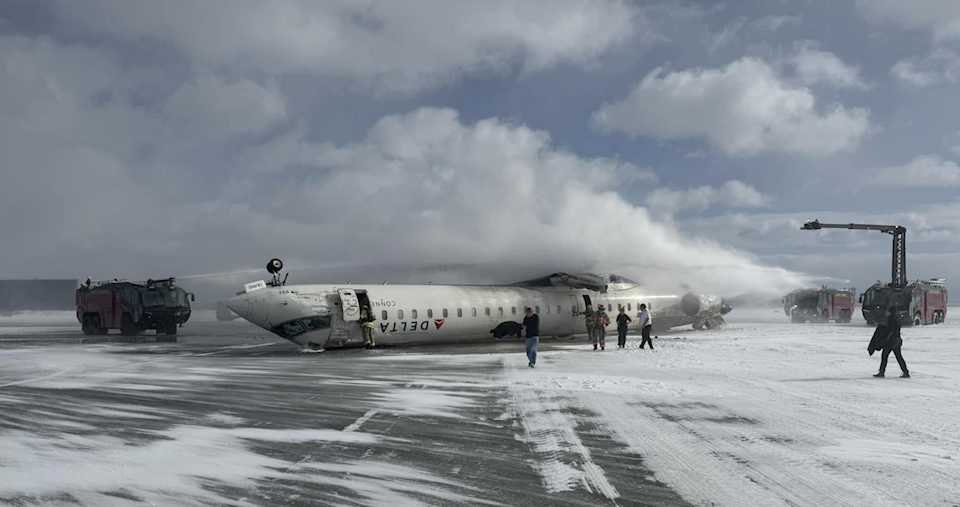Dramatic video captured the fiery crash of a Bombardier aircraft at Toronto's Pearson Airport on Monday afternoon.
Clearist footage showing the crash moment of Delta - Endevoir Air CRJ-900 Flight DL4819 from Minneapolis (MSP) to Toronto (YYZ) with registration N932XJ.
— aircraftmaintenancengineer (@airmainengineer) February 18, 2025
We will share the reports as soon as available. pic.twitter.com/4XRAdJt3c0
Endeavor Air operated the Delta Air Lines flight 4819. which had 80 people on board, 76 of whom were passengers and four of whom were crew members. Twenty-one people that were on board were injured three critically, including one child.
The flight originated from Minneapolis-Saint Paul International Airport and was scheduled to depart at 10:30 a.m. but it didn’t take off until 11:47 a.m. Monday.
The flight was scheduled to land at 2:13 p.m. but when the plane tried to land there were complications.
The Mitsubishi CRJ-900LR aircraft crash-landed on Runway 23 at Pearson and as it slid on the runway the aircraft’s cabin lost its wings and was flipped upside down.
John Nelson, a survivor of the Delta airline crash, shared what he witnessed and said he could see a fireball on the left side of the plane.
“I was upside down everybody else was there as well, thankfully everybody was okay,” he said.
“We tried to get out of there as quickly as possible, and shortly thereafter, after I finished filming the video, there was another explosion, but luckily, the firefighters got there,” he said.
The flight attendants' union, the AFA-CWA, said in an email message that "we activated our critical incident response team which provides mental health support and safety support for flight attendants in a crash like this."
The airport’s President and CEO Deborah Flint said yesterday she is extremely grateful to all the first responders and the flight crew who managed to keep the situation under control.
She said she could not comment on what caused the crash as it is under investigation.
Flint said operations at the airport would need time to recover as two runways remain closed due to the active investigation.
The Transportation Safety Board of Canada is expected to make a statement later today.
Toronto Pearson’s Fire Chief Todd Aitken said of the 18 people injured, 15 were rushed to a hospital, including a child who was air-flown to Toronto’s Hospital for Sick Children with critical injuries.
Delta CEO Ed Bastian expressed his gratitude towards first responders and team members on the scene.
“The hearts of the entire global Delta family are with those affected by today’s incident at Toronto-Pearson International Airport,” Bastian said in a press release. “I want to express my thanks to the many Delta and Endeavor team members and the first responders on site.”
The airport re-opened as of 5:00 p.m. for both arrivals and departures and has remained open since.
Toronto Aircraft Maintenance Inc., a Transport Canada-approved maintenance organization, works on a variety of aircraft types and sizes and is located near Pearson Runway 23.
A spokesperson for Toronto Aircraft Maintenance Inc. said the incident was random and the chances of a mechanical fault causing catastrophic failure are “extremely rare.”
“The incident, as far as yesterday’s, was simply an anomaly,” the spokesperson said.
“Pearson had hundreds and thousands of successful landings in similar conditions over the last several years without incident,” they said.
Despite potential system failures, aircraft are designed to compensate for mid-flight gremlins.
“The aircraft is designed to have system failures and still be able to perform in-flight and land safely,” the Toronto Aircraft Maintenance spokesperson said.
Harbouring mechanical skills to certify aircraft for commercial flight, Toronto Aircraft Maintenance said the CRJ 900 LR, which impacted and rolled over on runway 23, has no major design flaws which could cause the impact.
“The 900 has been refined over and over again, it’s pretty much the latest rendition of that type of aircraft,” they said.
“There are no systems on that [aircraft] that I would deem it as having an Achilles heel.”
The Mitsubishi CRJ900 is part of the air fleets for Delta Air Lines, Air Canada, American Airlines, Endeavor Air, Mesa Airlines, PSA Airlines, and SkyWest Airlines.
The CRJ900 seats 76 to 90 passengers and features general electric CF34-8C5 turbofan engines, upgraded and redesigned interior configurations and a cruising speed of 515 miles per hour (829 km/h).
According to Epic Flight Academy, the CRJ900 aircraft is designed to fly in extreme cold temperatures and can handle even the worst conditions in Alaska.
As of 2020 MHIRJ, part of the Mitsubishi Heavy Industries Group, services over 1300 CRJ series aircraft across the globe.
Humber Et Cetera reached out for an interview but the staff didn’t comment.
A video posted by Pete Koukov, or “eggxit” on Instagram, shows himself and passengers exiting the plane.
“Upon arrival of the crash site, our staff were faced with a multitude of different injuries, mainly stemming from back sprains, head injuries, anxiety, some headaches, nausea and vomiting due to the fuel exposure,” said Cory Tkatch, operations commander within Peel Region Paramedic Services.
Delta CEO Ed Bastian said the top priority is taking care of the impacted passengers and crew members.
“Our most pressing priority remains taking care of all customers and Endeavor crew members who were involved,” Bastian said in a press release.
“We’ll do everything we can to support them and their families in the days ahead,” he said. “We are grateful for all the first responders and medical teams who have been caring for them.”



